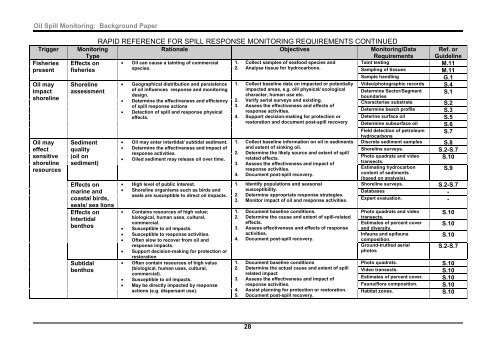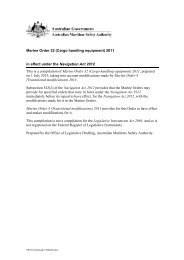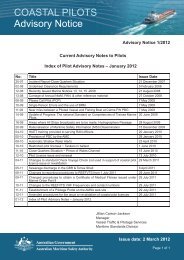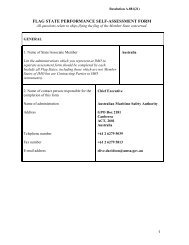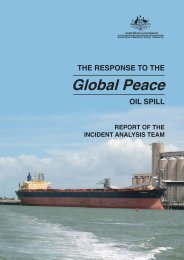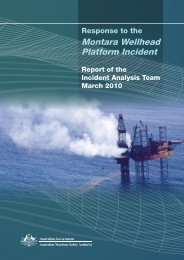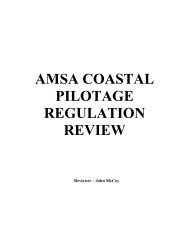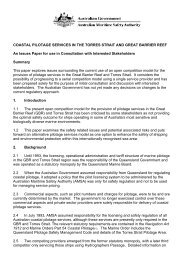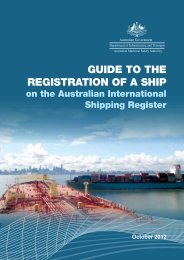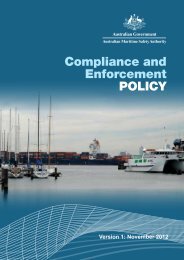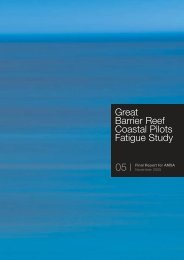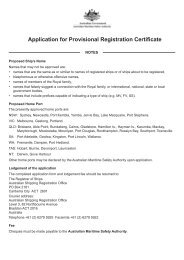Oil Spill Monitoring BACKGROUND PAPER - Australian Maritime ...
Oil Spill Monitoring BACKGROUND PAPER - Australian Maritime ...
Oil Spill Monitoring BACKGROUND PAPER - Australian Maritime ...
Create successful ePaper yourself
Turn your PDF publications into a flip-book with our unique Google optimized e-Paper software.
<strong>Oil</strong> <strong>Spill</strong> <strong>Monitoring</strong>: Background Paper<br />
RAPID REFERENCE FOR SPILL RESPONSE MONITORING REQUIREMENTS CONTINUED<br />
Trigger <strong>Monitoring</strong><br />
Rationale Objectives <strong>Monitoring</strong>/Data Ref. or<br />
Type<br />
Requirements Guideline<br />
Fisheries<br />
present<br />
Effects on<br />
fisheries<br />
• <strong>Oil</strong> can cause a tainting of commercial<br />
species.<br />
1.<br />
2.<br />
Collect samples of seafood species and<br />
Analyse tissue for hydrocarbons.<br />
Taint testing<br />
Sampling of tissues<br />
M.11<br />
M.11<br />
Sample handling G.1<br />
<strong>Oil</strong> may Shoreline<br />
Video/photographic records S.4<br />
impact<br />
shoreline<br />
assessment<br />
Determine Sector/Segment<br />
boundaries<br />
S.1<br />
<strong>Oil</strong> may<br />
effect<br />
sensitive<br />
shoreline<br />
resources<br />
Sediment<br />
quality<br />
(oil on<br />
sediment)<br />
Effects on<br />
marine and<br />
coastal birds,<br />
seals/ sea lions<br />
Effects on<br />
Intertidal<br />
benthos<br />
Subtidal<br />
benthos<br />
• Geographical distribution and persistence<br />
of oil influences response and monitoring<br />
design.<br />
• Determine the effectiveness and efficiency<br />
of spill response actions<br />
• Detection of spill and response physical<br />
effects.<br />
• <strong>Oil</strong> may enter intertidal/ subtidal sediment.<br />
• Determine the effectiveness and impact of<br />
response activities.<br />
• <strong>Oil</strong>ed sediment may release oil over time.<br />
• High level of public interest.<br />
• Shoreline organisms such as birds and<br />
seals are susceptible to direct oil impacts.<br />
• Contains resources of high value;<br />
biological, human uses, cultural,<br />
commercial.<br />
• Susceptible to oil impacts.<br />
• Susceptible to response activities.<br />
• Often slow to recover from oil and<br />
response impacts.<br />
• Support decision-making for protection or<br />
restoration<br />
• Often contain resources of high value<br />
(biological, human uses, cultural,<br />
commercial).<br />
• Susceptible to oil impacts.<br />
• May be directly impacted by response<br />
actions (e.g. dispersant use).<br />
1. Collect baseline data on impacted or potentially<br />
impacted areas, e.g. oil/ physical/ ecological<br />
character, human use etc.<br />
2. Verify aerial surveys and existing.<br />
3. Assess the effectiveness and effects of<br />
response activities.<br />
4. Support decision-making for protection or<br />
restoration and document post-spill recovery<br />
1. Collect baseline information on oil in sediments<br />
and extent of sinking oil.<br />
2. Determine the likely source and extent of spill<br />
related effects.<br />
3. Assess the effectiveness and impact of<br />
response activities.<br />
4. Document post-spill recovery.<br />
1. Identify populations and seasonal<br />
susceptibility.<br />
2. Determine appropriate response strategies.<br />
3. Monitor impact of oil and response activities.<br />
1. Document baseline conditions.<br />
2. Determine the cause and extent of spill-related<br />
effects.<br />
3. Assess effectiveness and effects of response<br />
activities.<br />
4. Document post-spill recovery.<br />
1. Document baseline conditions<br />
2. Determine the actual cause and extent of spill<br />
related impact<br />
3. Assess the effectiveness and impact of<br />
response activities.<br />
4. Assist planning for protection or restoration.<br />
5. Document post-spill recovery.<br />
28<br />
Characterise substrate S.2<br />
Determine beach profile S.3<br />
Deterine surface oil S.5<br />
Determine subsurface oil S.6<br />
Field detection of petroleum S.7<br />
hydrocarbons<br />
Discrete sediment samples S.8<br />
Shoreline surveys. S.2-S.7<br />
Photo quadrats and video S.10<br />
transects.<br />
Estimating hydrocarbon<br />
content of sediments<br />
(based on analysis).<br />
S.9<br />
Shoreline surveys. S.2-S.7<br />
Databases -<br />
Expert evaluation. -<br />
Photo quadrats and video<br />
transects.<br />
Estimates of percent cover<br />
and diversity.<br />
Infauna and epifauna<br />
composition.<br />
Ground-truthed aerial<br />
photos<br />
S.10<br />
S.10<br />
S.10<br />
S.2-S.7<br />
Photo quadrats. S.10<br />
Video transects. S.10<br />
Estimates of percent cover. S.10<br />
Fauna/flora composition. S.10<br />
Habitat zones. S.10


